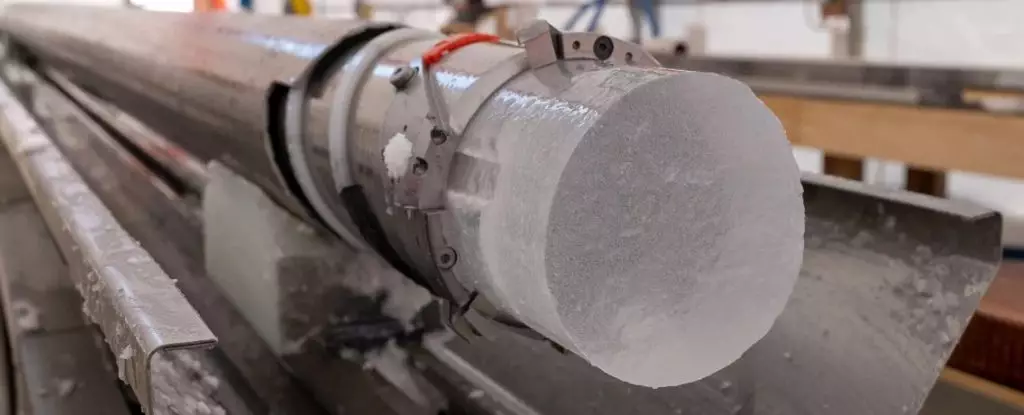Antarctica, often seen as a forbidding and desolate land, serves as a remarkable archive of Earth’s climatic history. The recently drilled ice core, stretching over an astounding 2,800 meters (about 9,186 feet), emerges as an invaluable scientific insight that promises to enhance our understanding of climate variations over the eons. Each segment of this core encapsulates nearly 13,000 years of geological heritage, marking an unbroken chronicle that reveals the dynamic interactions of atmospheric gases, temperatures, and ancient climates. This monumental effort not only lays bare the past but also serves as a critical benchmark against which we can measure the severe shifts instigated by human activity today.
Ice cores provide a unique glimpse into Earth’s past. These frozen strata hold microscopic air bubbles that allow scientists to extract atmospheric samples from epochs lost to time. When analyzed, these gases—including carbon dioxide and methane—reveal crucial details about historical atmospheres, temperature changes, and even ecosystem dynamics. By studying these ancient climates, researchers can predict future trends and better understand the effects of current global warming caused by anthropogenic emissions.
A Journey into Earth’s Climate Timeline
The chief scientist, Julien Westhoff, notes that the recently sampled ice is believed to contain records as old as 1.2 million years. Historical ice cores, such as the earlier EPICA findings revealed in 2004, only contained a climate record dating back approximately 740,000 years. Thus, the depth of this new core represents a significant leap into the past, suggesting that even older ice may exist in the uncharted depths. Interestingly, while the oldest ice discovered in Antarctica thus far is around 2.7 million years old, it lacks continuity. This new drilling effort could fill in critical gaps in our understanding, especially concerning periods of abrupt climate change.
The drilling location, Little Dome C, was methodically selected based on radar assessments which indicated not just the depth of the ice but the stability of the layer—layers that have remained undisturbed and unthawed over millennia. Such stability is vital for preserving the integrity of the bubbles trapped within the ice, which hold the key to reconstructing ancient atmospheres.
Strong evidence suggests the recent drilling corridor helps trace a time in Earth’s history marked by its glacial cycles. Between 900,000 and 1.2 million years ago, Earth experienced significant climate swings that remain a scientific enigma. Carlo Barbante, the director of EPICA, emphasizes the importance of understanding how greenhouse gases influenced these climate transitions. The new findings not only shed light on past extreme conditions but also help contextualize current trends in climate change.
Moreover, some theories propose that nearly 99 percent of early humans in Africa possibly perished during these severe cold periods. While this hypothesis is contentious and rooted in modern genetic studies, the new core sample could provide essential insight into the climate conditions of that era, helping us unravel whether these environmental challenges directly impacted human resilience.
As climate scientists strive to make sense of the current climate crisis, the discoveries made from the Antarctic ice core sampling become even more crucial. The current climate emergency drastically deviates from natural cycles documented in these ice layers, underscoring the anxiety amongst researchers about the trajectory of global temperatures linked to human influence. The unprecedented data being garnered promises to illuminate the intricate relationship between atmospheric gases and temperature fluctuations over vast timescales, refocusing scientific efforts on mitigating contemporary challenges.
Antarctica harbors approximately 90 percent of the Earth’s ice, and understanding its dynamics can reveal critical insights into our planet’s freshwater resources. The revelation of how Earth’s polar regions evolved will deepen our comprehension of climate patterns and the mechanisms governing glaciation and deglaciation processes.
The recent extraction of this colossal ice core signals a thrilling frontier for climate research. As Richard Alley, a noted climate scientist, aptly states, “They will learn wonderful things.” Each layer of ice extracted has the potential to yield extraordinary information about our planet’s history and shape the future of climate science. As researchers at EPICA continue their meticulous analysis, the implications of their findings for understanding climate change could not be more momentous. The Chronology held within the ice not only informs us of the past but also serves as a poignant reminder of our responsibilities to the future, urging a reconsideration of our current practices in light of nature’s historical lessons.


Leave a Reply